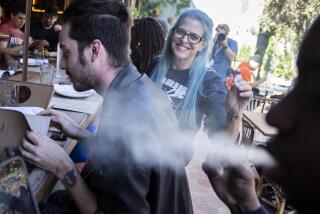Sign of Times: More Cities Just Saying ‘No Smoking’ : Health: Restaurants are the latest battle zone for ‘anti’ forces escalating their fight for tighter restrictions in public places.
LAGUNA BEACH — Amid all the stink over smoking, there are people like Gordon Carter.
Carter runs The Towers restaurant, a popular oceanfront spot with a postcard view of the Pacific Ocean. He is sympathetic to the concerns of nonsmokers, but he found himself in an untenable position when the city of Laguna Beach ordered him to set aside more and more seats for them.
What, he asked himself, would he tell the loyal, smoking customers who demand their favorite seats in what is now the new nonsmoking section? And who gets the ocean view, the smokers or the nonsmokers?
“A number of our higher-spending customers who order premium wines and expensive dinners are smokers,” Carter said recently. “It’s going to be very difficult to stand at the door and tell a customer who’s been with us for 10 years that he can’t sit at the table he normally sits at because it’s a nonsmoking table.”
Carter’s dilemma--brought on when the city passed a law requiring all eating establishments to set aside 60% of their seating for nonsmokers--is indicative of the problems facing restaurants across the Southland as the debate over smoking heats up.
From the artsy cafes of this seaside retreat to the trendy bistros in Santa Barbara, the restaurant is fast emerging as the latest battle zone in a relentless war waged by proponents of a smokeless society. Spurred by recent news reports of an Environmental Protection Agency draft study that blames secondhand smoke for the deaths of 3,000 nonsmokers a year, cities across Southern California have begun to tighten smoking restrictions at eating places.
And suddenly people like Carter have found that the spirit of accommodation that existed for years, providing for smoking and nonsmoking sections in most eating places, is under siege as nonsmokers press to set aside more and more space for those who choose not to smoke or be anywhere near those who do.
Last month, Laguna Beach raised the minimum requirement for nonsmoking seating in its restaurants from 25% to 60%. Shortly after that, San Luis Obispo passed one of the toughest anti-smoking ordinances in the region: As of next Thursday, smokers will be prohibited from lighting up not only in restaurants, but also in bars and most other public places as well.
And in a case that is being watched closely around the nation, Los Angeles is studying a plan to entirely ban smoking in restaurants. If passed, it would give the city the toughest anti-smoking regulations of any major metropolitan area in the country and could encourage others to follow suit.
The recent proposals, ranging from increasing the number of nonsmoking seats in restaurants to banning smoking altogether, are the latest weapons in the arsenal of an anti-smoking crusade to make it difficult, if not impossible, to find a place to smoke.
Anti-smoking activists believe their movement is gaining momentum and predict it is just a matter of time before smoking is outlawed in all public places.
“I used to feel that it was going to be a very uphill fight, but then someone pointed out to me that up until the 1930s there were spittoons on the streets,” said Santa Barbara Mayor Sheila Lodge, a nonsmoker.
In June, a nonsmoking waiter in Santa Barbara urged the City Council to pass an ordinance outlawing smoking in restaurants there. But officials decided to postpone the matter because some believed a ban would be too much to inflict upon citizens who are already suffering the effects of a prolonged drought.
Still, with the current atmosphere, nonsmoking advocates are optimistic that the proposal will be revived in the near future.
“I think as more of the evidence of the harmful effects of smoking becomes clearer and clearer it will become less acceptable,” Lodge said.
Banned from an increasing number of public places, smokers have become pariahs in an all-out anti-smoking offensive. Unable to smoke on domestic flights of less than five hours, they sit in airport waiting areas, blowing smoke like human chimneys. They linger outside government office buildings, puffing furiously to tide them over until the next break. They cluster together in smelly smoking rooms at work, sucking on their menthols. They wait in line at restaurants rather than take an available table in the nonsmoking section and suffer through a two-hour meal without lighting up.
But if the trend toward prohibition continues, there won’t be any smoking tables left to wait for.
“It’s ludicrous,” said Tunny Ortali, owner of McLintocks Saloon in San Luis Obispo, of the new smoking ban in all restaurants and bars. “We had nonsmoking sections before and there were never any complaints.”
Ortali, himself a nonsmoker, fears the ban that goes into effect next week will hurt tourism.
“I think it’s going to hurt with the Japanese visitors and the Europeans who are known for smoking,” he said. “Nonsmoking is the social trend, but mandating it is sickening.”
While few debate the obvious health hazards associated with smoking, many in the restaurant industry argue that government has overstepped its bounds in attempting to ban a practice that, while unhealthy, is not illegal. Others fear the laws will merely drive their clientele into neighboring cities that are more accommodating.
They cite the example of Beverly Hills, which attempted to prohibit smoking in all restaurants three years ago. The law lasted only 2 1/2 months and was repealed after intense pressure from the restaurant industry. During that time, the city’s 125 restaurants reported a 30% drop in business and state records showed about a 9% drop in taxable sales. The City Council now requires 60% of dining room seating to be set aside for nonsmokers.
Now, the city of Los Angeles is attempting to succeed where Beverly Hills failed.
City Councilman Marvin Braude, a reformed smoker, has proposed an ordinance that would outlaw smoking in all eating places--a proposal that the California Restaurant Assn. has vehemently opposed on the grounds that it unfairly singles out restaurants.
“If secondhand smoke is really an issue, then they think a ban should be across the board,” said Joe Linda Thompson, a Sacramento lobbyist for the association. “Why should someone be able to go to a bowling alley and smoke? What’s the difference?”
In an apparent counterproposal, the restaurant group said it would support a state bill to ban smoking in all public places, a move that anti-smoking advocates criticize as a thinly veiled attempt to scuttle the Braude plan. Restaurant officials have acknowledged it would be early next year before a state bill could be introduced in the Legislature, months after the outcome of the Los Angeles ordinance.
Despite tough opposition, Braude, who pioneered several no-smoking laws in the last decade, is standing firm.
“It was 257 days before I stopped counting the days. I had to suck gum drops until my mouth was sore to overcome that addiction,” Braude said. “I’m very sympathetic to smokers, but that doesn’t make me feel they have the right to create health problems for nonsmokers.”
Along with a $28-million anti-smoking advertising campaign by state health officials, local restaurant ordinances are yet another step toward turning smoking into a social taboo.
“One could argue that it is more difficult to smoke in Southern California settings then it is to take cocaine,” said William Schonfeld, dean of the School of Social Science at UC Irvine.
Jerry Cordell, a 48-year-old computer clerk, agrees.
A few months ago, he was reading the newspaper and smoking a cigarette at his neighborhood Laundromat in Capistrano Beach when a stranger took her clothes out of a dryer, plopped them on a folding table nearby and asked him to move.
“She said, ‘I don’t want my clothes smelling like your stinky cigarette,’ ” Cordell recounted. “At first, I stood up to move, but then I said, ‘Wait a minute, there’s no signs in here that say no smoking. Go to another table.’ ”
For Cordell, a pack-a-day smoker for 30 years, even designated smoking areas offer little respite from the increasingly hostile onslaught of nonsmokers. To make sure others got the message, Cordell, who works in the Orange County tax assessor’s office, hung a sign in the smoker’s lounge that reads, in bold black print, “This is a smoking area.”
But that didn’t stop someone from sneaking into the smoking room a few weeks ago and throwing the ashtrays in the garbage can.
“It’s gotten to the point where you pull out a cigarette and people look at you like a criminal,” Cordell said.
However, there is much debate over the effectiveness of peer pressure and increasing legislation in reducing smoking. While cigarette sales have dropped off dramatically, Philip Morris U.S.A., the largest tobacco company, is still selling more than 26 billion packs a year. Someone, industry officials point out, is smoking all those cigarettes.
“The idea is to shame people and embarrass them into not smoking or only doing it in their closet with the light off and the door closed,” said Brennan Dawson, a spokeswoman for the Tobacco Institute, an industry lobbying group. “I don’t think it’s working.”
But John Pierce, an associate professor at UC San Diego who has been commissioned by the California Department of Health Services to conduct a statewide smoking survey, believes the social pressure on smokers is slowly having its desired affect.
“There has been a huge shift toward smokers feeling uncomfortable with their habit,” Pierce said. “If you ask them if they intend to be smoking in five years’ time--far enough away so they don’t have to do anything about it right away--90% say they don’t plan to be. It isn’t that there is this group of people who are resistant to the messages and saying that they’re going to smoke no matter what. It’s just that they haven’t gotten around to quitting.”
It is as much a clash over lifestyles as public health issues, sometimes even pitting husband against wife. “When I light up in the den, my wife gets up and walks out,” said Robert Lo Prest, 67, a retired policeman in Costa Mesa who is a pack-a-day-smoker. “I’m a diabetic and I have high blood pressure. My doctor tells me, ‘Those cigarettes are killing you.’ Well I’ve been smoking 50 years and I’m not dead yet.”
However, it may only be a matter of time before he is forced to choose between staying home with his cigarettes or going out for a nice dinner.
“Nonsmoking restaurants are going to be the wave of the future,” said San Luis Obispo City Atty. Jeff Jorgensen. “I think 20 years from now, the fact that there was any argument over it will seem strange.”
Times correspondent Lisa Mascaro contributed to this report.
More to Read
Sign up for Essential California
The most important California stories and recommendations in your inbox every morning.
You may occasionally receive promotional content from the Los Angeles Times.










